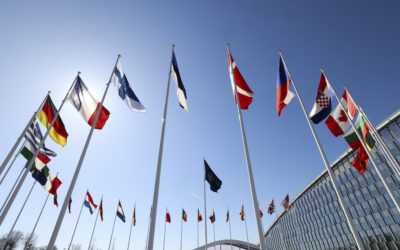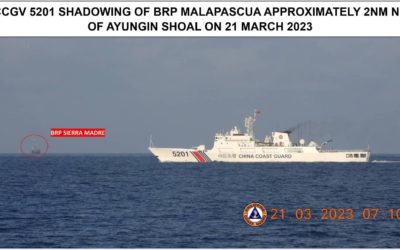The Marine Corps is ready to use its new formation developed for the island-to-island fight of the future in a major joint exercise in the Indo-Pacific for the first time.
After conducting a service-level exercise in California and Arizona earlier this year, the Marine Corps will now scale that experimentation to the naval and joint force level during exercise Balikatan in the Philippines.
President Marcos Jr. Meets With President Biden—But the U.S. Position in Southeast Asia is Increasingly Shaky
President Marcos Jr. Meets With President Biden—But the U.S. Position in Southeast Asia is Increasingly Shaky
President Marcos Jr. Meets With President Biden—But the U.S. Position in Southeast Asia is Increasingly Shaky
President Ferdinand Marcos Jr.’s visit to Washington represents a significant deepening of the U.S.-Philippines relationship. But many other Southeast Asian countries are increasingly turning to China.
Over a four-day visit to Washington, Philippine President Ferdinand Marcos Jr. has been welcomed to the White House and generally feted across Washington. With President Biden, Marcos Jr. (whose father was forced out of office in part through U.S. pressure, and whose family has little love for the United States) affirmed that the two countries are facing new challenges, and Biden said that “I couldn’t think of a better partner to have than [Marcos Jr.].”
Indeed, as the New York Times noted, Biden and Marcos discussed facilitating greater bilateral trade and increased U.S. investment in the Philippines, which has poor infrastructure and has lagged behind some other countries in the region as a potential market for companies concerned about being solely reliant on keeping operations in China. But as the Times further noted, the centerpiece of the warm meeting was that “the Filipino leader planned to deepen his country’s relationship with the United States,” which he has already initiated by holding joint exercises with the U.S. military and allowing the Pentagon to bolster its presence in the Philippines at four new sites. In the case of conflict over Taiwan, these sites in the Philippines, a U.S. treaty ally, and the Philippines in general, would be crucial for U.S. forces—who might not be able to depend on their other treaty ally in Southeast Asia, Thailand, which has warm relations with China.
Like many countries in Southeast Asia, the Philippines has for years tried to walk a tightrope, remaining close (and now closer) strategically to the United States while becoming increasingly economically dependent on China. Yet while Marcos Jr.’s decision to align more clearly with the United States, particularly with the Department of Defense, was welcome in Washington, his choice is actually fairly unique. Overall, the pendulum in the region is swinging toward China, with Beijing rapidly becoming by far the most influential state in the region—and thus well-positioned to prevent many other countries from copying Marcos Jr.’s actions.
Indeed, a recent, very important study by the Lowy Institute showed that only two Southeast Asian states, the Philippines and Singapore, still consider the United States more influential in Southeast Asia than China—and even in those countries, the margins of people saying the United States was more influential was relatively small. In a similar study by Lowy four years ago, the United States was perceived as more influential than China in more Southeast Asian countries than it is today.
In every other state—even in ones with serious strategic disputes with China, like Vietnam—people said that China was now the region’s most influential state. This comes after the United States ignored the region’s trade integration for years, offering no participation in the web of binding trade deals in Southeast Asia, and to some extent during the Trump administration, ignoring parts of the region completely. In addition, in a region that has become increasingly authoritarian, the U.S. focus on rights and democracy has mostly been ignored. Meanwhile, China has actively participated in the region’s trade integration, offered significant aid and investment to many regional states, and is increasingly becoming an important rescue lender when countries need emergency aid packages.
To be sure, some Southeast Asian states beyond the Philippines, like Singapore and Vietnam, remain terrified of China’s increasingly assertive behavior in the South China Sea, in its formal diplomacy, and its actions in the waters and airspace around Taiwan. But nearly all of the region is increasingly tilting toward China, which has become so dominant economically—its trade relationship with the ten states of ASEAN is around one trillion annually. Even longtime democrats like Anwar Ibrahim, prime minister of Malaysia and a longtime friend of the United States, are increasingly and aggressively seeking closer ties with China in exchange of course for greater investment and trade. So while Washington may be celebrating Marcos Jr.—and without a doubt, the new facilities and closer defense ties in the Philippines are important in the increasingly tense environment around Taiwan—much of the rest of the region is turning away from Washington.
Republished from the Council on Foreign Relations under a Creative Commons license in the United States.

Joshua Kurlantzick is senior fellow for Southeast Asia at the Council on Foreign Relations (CFR). He is the author, most recently, of Beijing’s Global Media Offensive: China’s Uneven Campaign To Influence Asia and the World. Kurlantzick was previously a visiting scholar at the Carnegie Endowment for International Peace, where he studied Southeast Asian politics and economics and China’s relations with Southeast Asia, including Chinese investment, aid, and diplomacy. Previously, he was a fellow at the University of Southern California Center on Public Diplomacy and a fellow at the Pacific Council on International Policy. He is currently focused on China’s relations with Southeast Asia, and China’s approach to soft and sharp power, including state-backed media and information efforts and other components of soft and sharp power. He is also working on issues related to the rise of global populism, populism in Asia, and the impact of COVID-19 on illiberal populism and political freedom overall.
Related Articles
Finland, NATO and the evolving new world order – what small nations know
In the world of geopolitics, great powers make, break and play by their own rules. Smaller states largely have to make do with adjusting to the world as determined by others.
Which is why the decision by Finland – a country of just 5.5 million people, noted for decades as a neutral presence in Europe – to join NATO is so important. It underscores just how the Russian invasion of Ukraine has upset global realities long thought settled, at least by the Western powers.
Chinese War Ships, Cutters Still Sailing Near Philippine Holdings in South China Sea
China Coast Guard ships and a People’s Liberation Army Navy (PLAN) corvette continue to operate around Philippine holdings in the Spratly Islands along with Chinese-flagged civilian ships, the Philippine Coast Guard (PCG) said Thursday.



